Browse using the new Vinous website now. Launch →
Printed by, and for the sole use of . All rights reserved © 2015 Vinous Media
Unpacking Oregon's Multi-Faceted 2023 Vintage
BY ERIC GUIDO | JULY 31, 2025We can no longer make assumptions based on broad generalizations about Oregon vintages. I recently returned from a two-week trip where I traveled and tasted across the most critical regions in the state's east and west. It’s easy to say that 2023 was just another warm year in a string of warm-to-hot vintages that have become the norm throughout the state. However, as I continued to taste, I realized that I could not simply label 2023 as a year defined by easygoing, fruit-forward wines. In fact, of the 1,000+ wines I tasted for this report, the riper, juicier wines were the ones I found myself questioning most often. There are, without a doubt, wines from the 2023 vintage that are challenged. Some lack complexity, others are light in structure, and some are far from balanced. However, on the flip side, the vast differences from place to place and producer to producer bear consideration. I found myself enamored with the florality, verve and energetic personalities of many 2023s. Although it is not a consistently excellent year, many winemakers achieved greatness. To write 2023 off as simply another warm vintage would be a mistake.
Talking to winemakers, I heard vastly different stories from place to place. Mikey Etzel of Beaux Frères in Ribbon Ridge spoke of an excessively warm and dry season saved by rains before harvest. Desiccation among the bunches required severe sorting and gentle winemaking. In contrast, Ben Casteel of Bethel Heights Vineyard in the Eola-Amity Hills, described a relatively easy season where he “never felt chased by the sun.” Somewhere in the middle, Josh Bergström, who produces wines from across Willamette Valley, explained that 2023 was the third warmest vintage in Oregon history, but it was a “balanced heat” with dry conditions that warded off disease pressure. In Dundee, Jim Maresh of Arterberry Maresh spoke in detail about his earlier pick dates in 2023, looking for “al dente” fruit, as opposed to the typical Oregon paradigm he described as “picking overripe.” Evan Martin of Martin Woods in McMinnville, who also sources from the Eola-Amity Hills, commented, “I couldn't believe how early we were picking, about a week earlier than usual. But it's better to pick early than to pick late. In the end, we have lower alcohols than usual but great density.” Ultimately, all five of these winemakers made excellent wines in 2023.
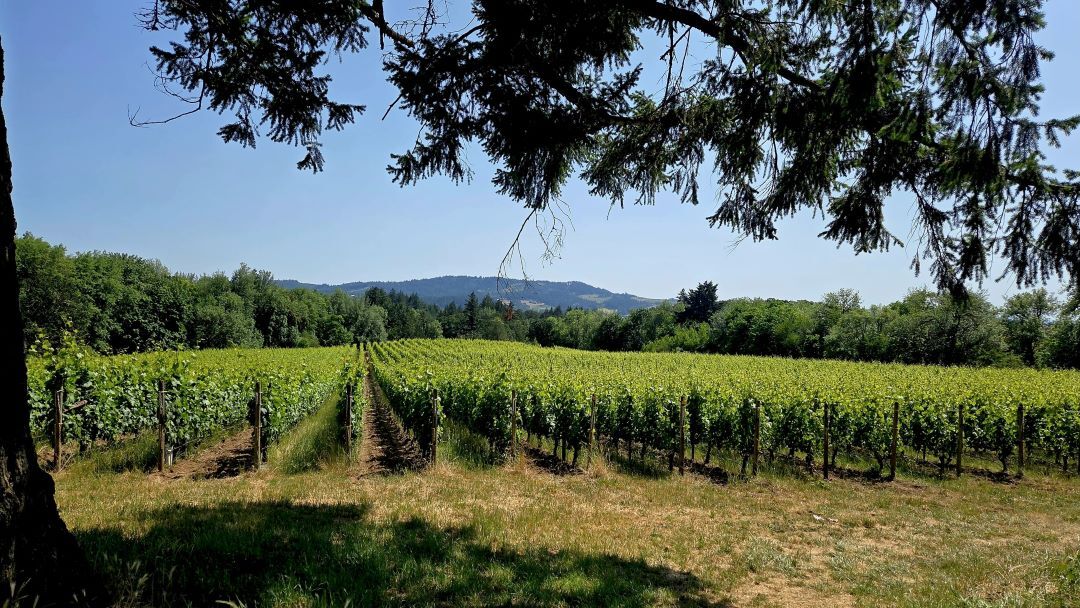
Tasting in the vineyard with Rollin Soles of ROCO Winery.
Consider the three years preceding 2023. The 2020 vintage had smoke issues from wildfires. A severe heat dome defined the 2021 season. In 2022, a killing frost wreaked havoc across the region. It’s easy to see why many producers would be happy with conditions in 2023. Nobody can deny that 2023 was a compressed season. The year started unseasonably cold, leading many to think they might see a repeat of 2011. Cool temperatures resulted in a late budbreak, while things began to warm up in May. This trend continued throughout the summer, coupled with arid conditions. The lack of extreme heat spikes and the regularity of significant diurnal shifts helped maintain acidity and balance in the fruit. Still, worries remained that grapes would not reach physiological ripeness due to the late budbreak. The saving grace came in the fall with well-timed rains in September and an Indian summer through October and November, allowing grapes to reach a healthy level of ripeness. However, in many cases, everything seemed to ripen simultaneously, leading to a rushed harvest. Unusually, some winemakers harvested Chardonnay and Pinot Noir within a week or two of each other. In my tastings, the 2023 Chardonnays outpaced the 2023 Pinot Noirs in quality, having gained more depth and complexity from the long hangtime. The Chardonnays are still sun-kissed in character, but they are more consistently successful across the region.
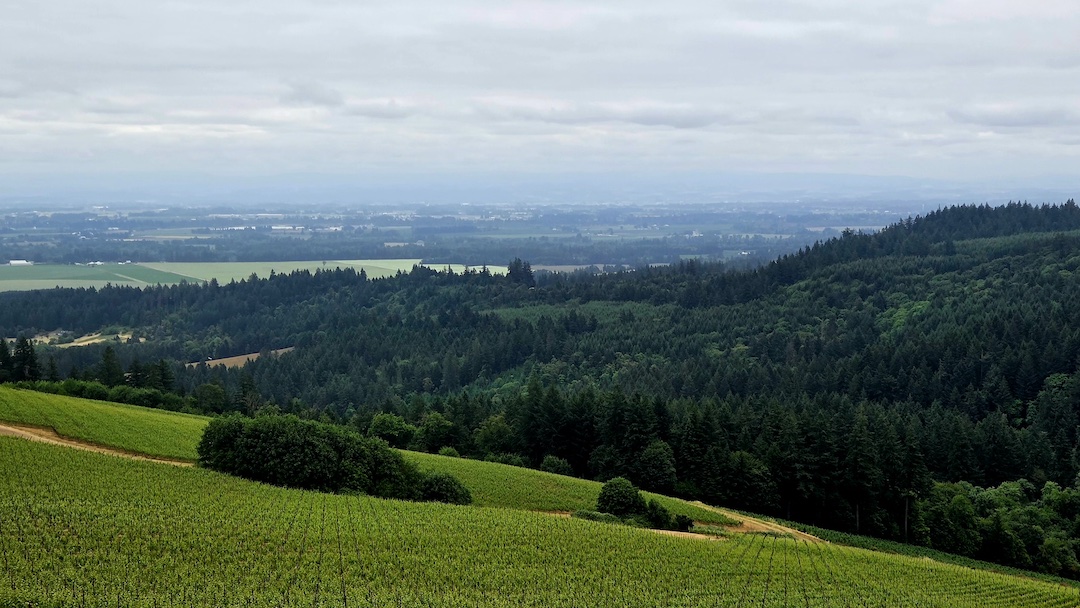
The Koosah Vineyard in the Eola-Amity Hills.
My biggest question is how the 2023 Pinot Noirs and Chardonnays will mature over time. Many wine lovers typically associate longer drinking windows with quality. For those consumers, the 2023 vintage may fall flat. The best 2023s succeed primarily because their creators leaned into the style of the year. These producers didn’t attempt to make the wines seem more structured or complex through extended macerations or longer barrel-aging, instead allowing their naturally vibrant fruit to shine. Many of the wines in the following notes are already showing beautifully and have the balance to mature evenly for several years, but very few will require extensive cellaring to show their best. The 2023s will certainly deliver for those who enjoy Pinot Noirs built on purity and site transparency. The 30+ single-vineyard Pinot Noirs in Patricia Green Cellars' portfolio are a testament to just that.
At the other end of the spectrum, many 2023s come across as simple, fruity, juicy and fun, which is fine at lower price points but problematic at the higher end. A fair number of wines either lack structure or, conversely, show elevated oak tannins that feel out of place. Some portfolios lack site transparency—I occasionally found myself tasting through a lineup of ten or more wines that came across as so similar that I struggled to differentiate them. In tasting 2023s next to 2022s, the 2022s are more classic in feel. Also, the 2023s lack the bold fruit profile and formidable structure that continue to make the 2021s so exciting.
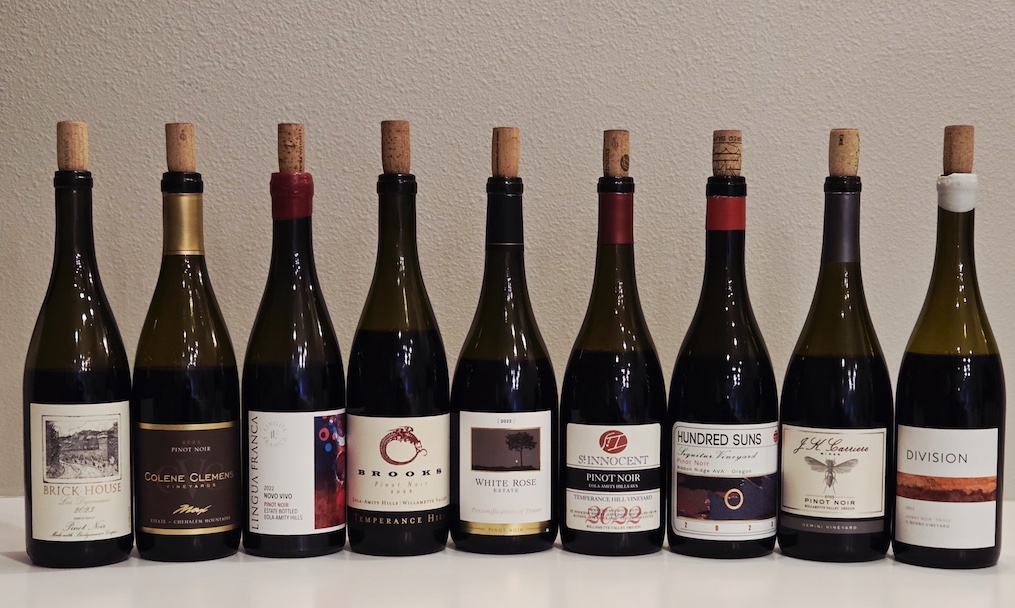
Contrasting Pinot Noirs from the 2023 and 2022 vintages.
It's important to make selective buying decisions. This vintage yielded many fantastic wines and a lot of great success stories, but many estates simply did not reach the heights of their best years.
The Ever-Expanding Oregon Wine Scene
Oregon is one of the most dynamic wine regions on earth, more so than most people realize. The Willamette Valley, long recognized as Oregon’s most essential wine region, spans about 150 miles in the western part of the state. The Oregon coastal range separates the Willamette Valley from the Pacific Ocean, and the Cascade Mountains form the eastern border. There are 11 sub-AVAs within the Willamette Valley, each with unique characteristics. Conditions can vary drastically within any given vintage across these subregions. For instance, Eola-Amity Hills is generally cooler and has excelled through the last decade of warm vintages. But in a cold vintage, winemakers in the Eola-Amity Hills might struggle to ripen their fruit early enough to avoid autumn rains. The same can be said for the Van Duzer Corridor, located just west of the Eola-Amity Hills. Here, the constant ventilating winds from the Pacific Ocean create an even cooler climate with drastic diurnal shifts. Out of 59,000 total acres, only 1000 acres of the Van Duzer Corridor are planted to grape vines. Pinot Noir here typically has thicker skins and higher acidity. Due to the climate, it’s not uncommon to find varieties like Grüner Veltliner, Pinot Blanc and Riesling planted here.
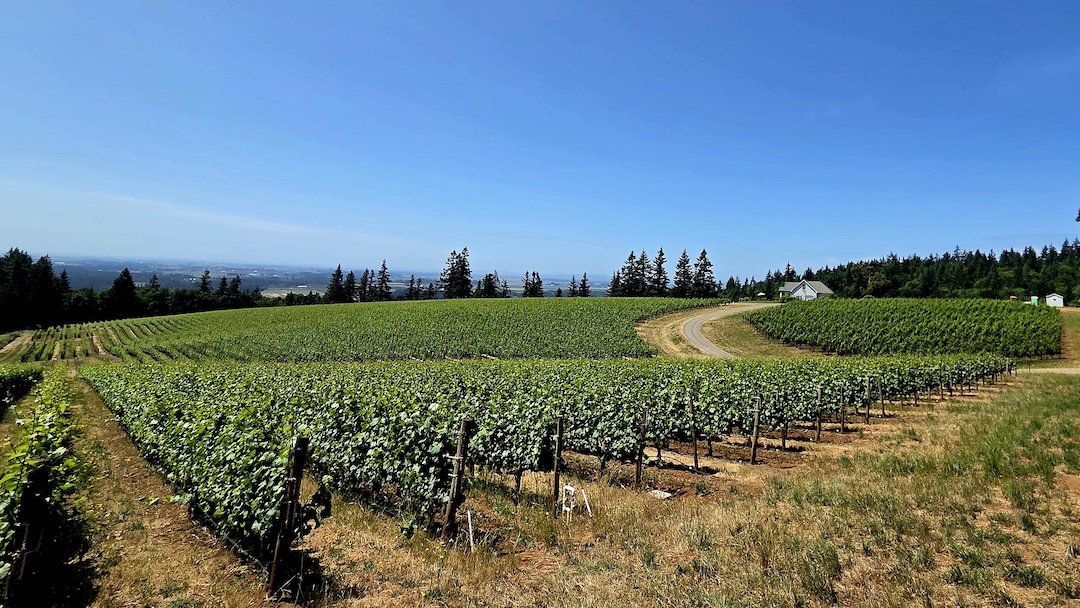
Le Cadeau Vineyard in the Chehalem Mountains AVA.
The Umpqua Valley and Rogue Valley (which includes Applegate Valley) are situated south of the Willamette Valley. These locations are warmer and consistency with regard to quality can be an issue, but several producers here manage to make excellent wines. Plantings run the gamut from Bordeaux to Rhône varieties, plus Pinot Noir, Chardonnay, Chenin Blanc, Malbec, Tempranillo and even Barbera. Out of the 1,000+ wines I tasted for this report, just under 100 came from these southern AVAs.
Then there’s The Rocks District of Milton-Freewater (which I will refer to as The Rocks going forward). This region is quickly gaining international recognition. Whereas the Willamette Valley is all about Pinot Noir and Chardonnay, The Rocks excels with red and white Rhône varieties and a unique take on Cabernet Sauvignon. These wines burst from the glass with the stamp of terroir. The climate and soils in this part of Oregon couldn’t be more different from the Pacific-influenced, predominantly volcanic and marine sedimentary soils of the western part of the state. The Rocks is located in the extreme northeast of the state, centered just five miles south of Walla Walla, Washington. It’s identified by its singular soil series, the Freewater Series, which consists of gravelly silt-loam and cobbly loam (primarily along the region’s borders). To the naked eye, these soils don’t appear to be soil at all, but rather rounded cobblestones and river stones. The area comprises a large alluvial fan that flattens out along the low foothills of the Blue Mountains and Walla Walla River valley on gradual slopes between 800 and 1,000 feet in elevation. It is important to note that vintages in The Rocks more closely resemble those of Eastern Washington than Western Oregon.
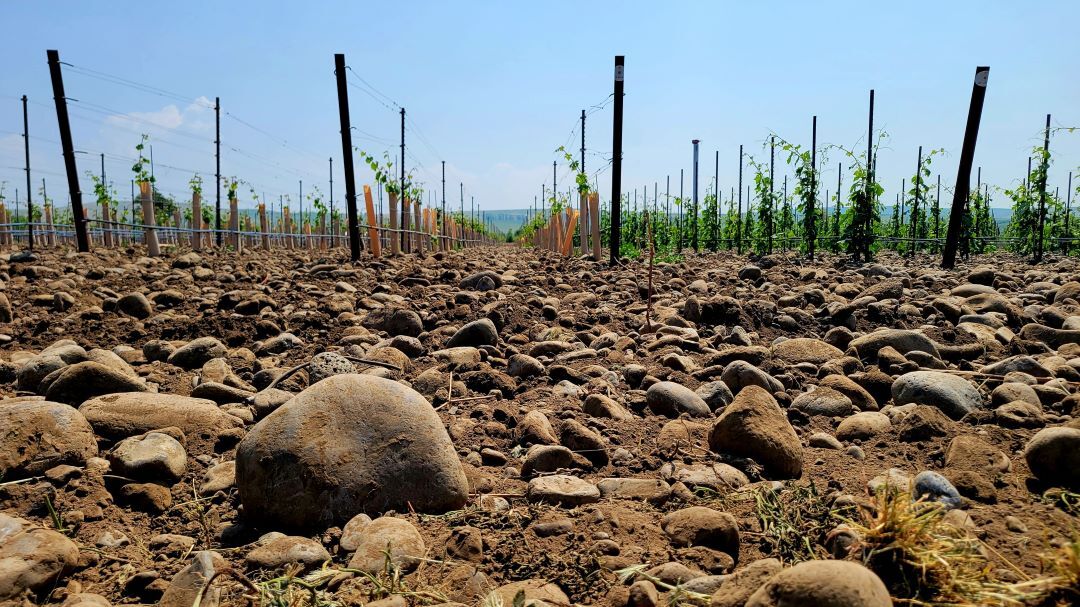
Deep in The Rocks.
The Rocks District celebrates its official tenth birthday as an AVA this year, but its rise in popularity began almost two decades ago. Cayuse brought fame to the area, referring to the region as “The Stones” and labeling the wines under the Walla Walla Valley AVA. Most consumers have long incorrectly identified The Rocks as part of Washington State, since wineries from both Oregon and Washington can make wines from the area. Curiously, Washington-based producers must have a winemaking facility in Oregon to label wines with the AVA designation, even though they were predominantly responsible for the marketing that brought attention to the region.
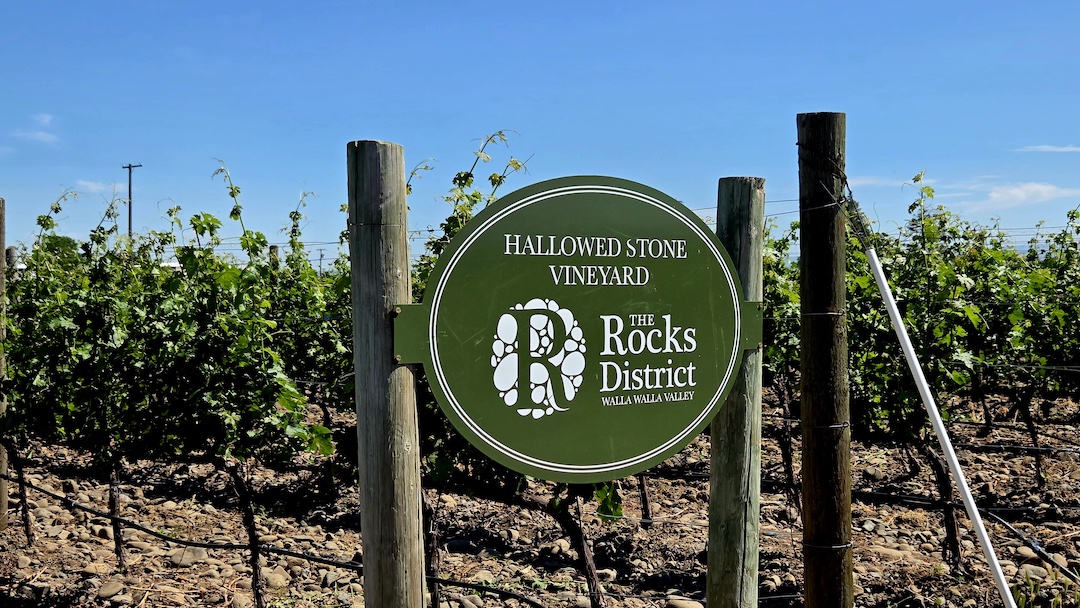
The Hallowed Stone Vineyard in The Rocks District of Milton-Freewater.
Today, however, things are changing rapidly, and I hope that the managing bodies within Oregon are paying full attention. When I taste in Oregon, I invite all wineries within the state to submit samples. I do not limit my tastings to the Willamette Valley. Each year, an increasing number of Oregon wineries source fruit from The Rocks. I expect that this trend will continue to gain momentum over the coming years as more and more winemakers get excited about this unique piece of terroir. As they do, it will be interesting to observe which producers will remain firmly attached to Washington and which may associate themselves more closely with Oregon. Ultimately, they are all proud to consider themselves part of the Pacific Northwest. Still, we may have a bit of a rocky road ahead (no pun intended) as we figure out how to talk about this region. As for producers firmly rooted in Oregon who make wines from The Rocks, check out Martin Woods, Le Cadeau, Hundred Suns, Violet Vines, White Rose Estate, Ricochet Wine Co. and Big Table Farm.
With all of that said, the Willamette Valley is in no danger of losing its relevance or taking a back seat to The Rocks. It is, in my opinion, one of the most important regions in the United States for top-flight Pinot Noir and Chardonnay. Boasting a wide diversity of terroir and an extensive list of high-caliber winemakers, the Willamette Valley has captured the attention of the wine-loving public and numerous winemakers worldwide, including those in Burgundy. The question is whether it will share some spotlight with the new kid on the block. No matter how you look at it, the Oregon wine industry is on the cusp of greatness.
I tasted the wines in this report in Oregon in May and June 2025 through organized tastings and producer visits, with follow-up tastings in our offices in New York City.
© 2025, Vinous. No portion of this article may be copied, shared or redistributed without prior consent from Vinous. Doing so is not only a violation of our copyright but also threatens the survival of independent wine criticism.
You Might Also Enjoy
Oregon 2022: The Rollercoaster Vintage, Eric Guido, August 2024
Sitting Pretty: Oregon's New Release Pinot Noir, Chardonnay and Beyond, Eric Guido, January 2024
Oregon’s 2019 Pinot Noirs - A Return to Classicism, Josh Raynolds, February 2022
Oregon Outside the Pinot Noir Box, Josh Raynolds, September 2020
Show all the wines (sorted by score)
- 00 Wines
- Abacela
- Abbott Claim
- Agathodaemon
- Airlie
- Alchemist
- Alexana Estate
- Alloro Vineyard
- Amalie Robert
- Amity Vineyard
- Amity Vineyards
- Anacréon Winery
- Antica Terra
- Antiquum Farm
- Approachment Wine Company
- Arborbrook Vineyards
- Argyle
- Arterberry Maresh
- Asilda Winery
- Averaen
- Beaux Frères
- Benton-Lane
- Benza Vineyards
- Bergström Wines
- Bethel Heights
- Big Table Farm
- Bjornson Vineyard
- Boedecker Cellars
- Brick House
- Brooks
- Bryn Mawr Vineyards
- Caballus
- Carlton Cellars
- Carlton Hill Vineyard
- Carlton-Hill Vineyards
- Chehalem
- Chosen Family Wines
- Coelho Winery
- Coeur de Terre Vineyard
- Colene Clemens Vineyards
- Composition
- Compris Vineyard
- Cooper Mountain Vineyards
- Corollary
- Cristom Vineyards
- Crowley Wines
- DANCIN Vineyards
- Del Rio Vineyard Estate
- Dion Vineyard
- Division Wine Co.
- Dobbes Family Winery
- Dois Irmaos Winery
- Domaine Drouhin Oregon
- Domaine Roy & Fils
- Domaine Serene
- Domaine St Laurent
- Domaine Willamette
- Dominio IV
- Dowsett Family Winery
- Drouhin Oregon Roserock
- Duck Pond
- EIEIO & Company
- Élevée Winegrowers
- Et Fille Wines
- Evening Land Vineyards
- Evesham Wood
- Evolution by Sokol Blosser
- Evolution By Sokol Blosser
- Fairsing Vineyard
- Fennwood
- Firesteed
- Flâneur Wines
- Franchere
- Fritzsche
- Fullerton Wines
- Furioso Vineyards
- Gemini Vineyards
- Goodfellow Family Cellars
- Gran Moraine
- Grochau Cellars
- Guillen Family Wines
- Haden Fig
- Hamilton Russell
- Hanson Vineyards
- Holmes Gap Vineyard
- Holocene
- Hundred Suns Wine
- Iota Cellars
- Irvine & Roberts
- Irvine & Roberts Vineyards
- Jachter Family Wines
- J.K. Carriere
- Johan Vineyards
- Jolete
- Kelley Fox Wines
- King Estate Winery
- Kings Ridge
- Knudsen Vineyards
- Lachini Vineyards
- Lange Estate Winery
- La Randonnée
- La Randonnée Wines
- LAVINEA
- Le Cadeau
- Left Coast Estate
- Lemelson
- Lenne Estate
- Lingua Franca
- Liska
- Lonesome Rock
- Martin Woods
- Mendivia Wines
- Morgen Long
- Nicolas Jay
- North Valley Vineyards
- Nysa
- Olenik
- Open Claim
- Pambrun Wines
- Panther Creek Cellars
- Patricia Green Cellars
- Paul O'Brien Winery
- Penner-Ash
- Phelps Creek Vineyards
- Pike Road Wines
- PROJECT M Wines
- Purple Hands Winery
- Quady North
- Rain Dance Vineyards
- Red Electric Wines
- Redolent
- Resistance Wine Company
- Ricochet Wine Co.
- Ridgecrest Wines
- ROCO Winery
- Rose & Arrow Estate
- Saffron Fields Vineyard
- Sequitur
- Shea Wine Cellars
- Shumaker Vineyards
- Sokol Blosser
- Sokol Blosser Winery
- Soléna Estate
- Soter Vineyards
- Stephen Goff Wines
- St. Innocent Winery
- Stoller Family Estate
- Suzor Wines
- Sweet Cheeks Winery
- Tan Fruit
- The Eyrie Vineyards
- The Potter's Vineyard
- Toil Oregon
- Trisaetum
- Troon Vineyard
- Underwood
- Valley View Winery/Domaine Rogue
- Van Duzer Vineyards
- Vincent Wine Company
- Violet Vines
- Walla Walla Vintners
- Walnut Ridge Vineyard
- Walter Scott
- Weisinger Family Winery
- White Rose Estate
- Willajory
- WillaKenzie
- Willamette Valley Vineyards
- Willful Wine
- Winderlea Vineyard And Winery
- Winter's Hill
- Witness Wines
- X Novo
- Yamhill Valley Vineyards
- Zena Crown
- Zenith Vineyard
